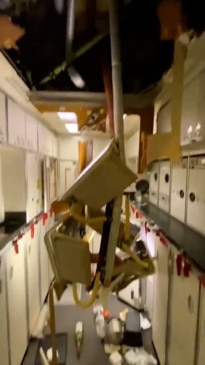A dozen Australians remain in hospital after a Singapore Airlines flight suffered extreme turbulence during a flight from London this week, with three in intensive care.
The Boeing 777 made an emergency landing at Bangkok on Tuesday after the plane dropped 6000ft in only a few minutes, crashing passengers up into the cabin roof.
British man Geoffrey Kitchen, 73, died on-board and up to 20 people are being treated at intensive care units in Thailand.
That includes three Australians at the Samitivej Srinakarin Hospital, where another six compatriots are receiving care for their injuries, according to the Sydney Morning Herald.
An Adelaide man told the ABC his wife could be in the hospital for weeks, saying she “wasn’t in a good way”.
At least 70 people were injured when the aircraft hit an air pocket about 10 hours into the flight from the UK capital.
On board staff were serving breakfast at the time, with witnesses reporting people “doing somersaults” when the plane suddenly dropped.
There were 56 Australians on the flight carrying 229 passengers, with some having now returned home on Wednesday afternoon.
Beverley Mayers told media at Sydney Airport of the “pure shock and fear” she felt when the emergency situation unfolded.
“I woke up crying on the plane, and I don’t normally cry,” the 81-year-old from Port Macquarie said.
“I think we all thought the plane was going to fall apart, I thought it was going to go in halves here.”
More Australians are expected to arrive home in coming days.
Thorough investigation
Singapore’s Prime Minister Lawrence Wong has promised a “thorough investigation” into flight SQ321 and offered his condolences to Mr Kitchen’s loved ones.
“I also hope and pray that those who are injured will recover and return home soon,” he said.
Singapore Airlines boss Goh Choon Phong said he was “deeply saddened” by the events.
Tim Atkinson, an aviation consultant and a former aircraft accident investigator, claimed turbulence was becoming more common and severe because of climate change.
Most turbulence occurs in cloud and is fairly mild, but can be more severe in large clouds such as the cumulonimbus thunderstorm cloud.
However another type of turbulence called “clear air” turbulence, which typically occurs in the jet stream around 40,000-60,000 feet, is difficult to detect and can cause sudden emergencies.
Speaking to Sky News, Mr Atkinson said “it’s fairly clear” the Singapore Airlines flight “encountered atmospheric turbulence”.
He noted that the area — called the Intertropical Convergence Zone — is “renowned among pilots, and I dare say passengers, for turbulence”.
“Despite abundant caution occasionally, there’s turbulence ahead which can’t be identified, and the unfortunate result of an encounter is injury and, very rarely, fatality,” he said.
Victim remembered
Theatre devotee Mr Kitchen was from Thornbury, a town in Gloucestershire in England’s south west north of Bristol.
The Sun reported he and wife Linda were beginning a six week holiday to Singapore, Indonesia, Japan and Australia when tragedy hit.
He was an amateur actor and former finance worker who has been described as “a really nice bloke” by friends.
“He was a really nice guy. I last saw them on Sunday night and my wife saw them drive off on Monday,” Mr Kitchen’s neighbour Steve Dimond told The Sun.
Lizzie Atkins, another of Mr Kitchen’s friends and a member of his theatre group, described him as a “remarkable man”.
Mr Kitchen and his wife were both “adventurous travellers” and their trip “had been planned for a very long time,” Ms Atkins told the BBC.
“They loved to travel and this was something they were particularly looking forward to.”
